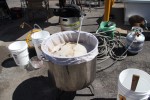
Time and time again I have told friends, family, and really anyone who will listen that the single most important thing about brewing great beer isn’t access to great hops. It isn’t expensive equipment, rare ingredients, or some sort of recipe genius. The single most important thing at any level of brewing has got to be cleanliness. Without it, even the greatest beer can be spoiled, and with it, the worst you can do is mediocrity. If you are looking for easy ways to improve your product on commercial or homebrew scales, look first to your cleaning procedures. If there is anywhere you are not being as clean as you can be, you are missing out on an opportunity to improve what you do and courting potential disaster. Let’s spend a little time exploring a few details of brewery cleaning.
First, let’s clarify a little bit what we mean by “cleaning”. There are generally two parts to this. The first is cleaning proper, which is designed to remove material from the surface at issue. Sometimes this is removal of liquid. Other times there is solid matter to remove. Often both must be cleaned away. After the cleaning proper is done, many brewery surfaces must then be sanitized. This is just as important as cleaning because microorganisms can be some of the greatest culprits when it comes to bad beer, but it is vital to note that sanitizing can only be done effectively after cleaning has already taken place. If you have a filthy line or tank and you swish some sanitizer around in it, don’t expect it to be either clean or sanitary. It will probably just be dirty and wet.
There are nearly as many proper cleaning procedures as there are surfaces to clean, so always check with the manufacturer of a given piece of equipment for recommended cleaning procedures. To get you started, though, let’s walk through a few basics I see around the brewery all the time. Every good cleaning procedure starts with a water rinse. Sometimes hot water is appropriate, and other times cold is more suitable. The objective is simply to remove the bulk of the soil without damaging the surface to be cleaned.
After rinsing, one of three general chemical types is commonly used. Surfactants, caustics, and acids can all be found in the chemical stores of most breweries. Surfactants, such as most soaps and detergents, are generally used for cleaning surfaces that are not overly soiled or surfaces that can easily be agitated with a pad or brush of some kind. They work by reducing surface tension of water, effectively making it “wetter” so that it removes other material more easily. Caustics are also common brewery cleaners as they tend to be very effective at removing organic soils. They work by softening organic material and making it easier to remove. The third broad type of cleaner is acid-based, which is commonly used for the removal of inorganic material such as beer stone by dissolving it. Always research the surface you are cleaning as well as the cleaning agent you plan to use. Some materials tend to perform better or worse when exposed to various cleaners, and you want to make sure that you aren’t going to harm the thing you are trying to clean or harm yourself. For example, rubber parts tend to degrade more quickly when exposed to acids. For another example, blending strong acids with chlorine-based caustics often causes the creation of the deadly toxin chlorine gas. Avoid this. Please.
Once a surface is adequately cleaned and the cleaning chemical adequately rinsed off, the surface often must be sanitized to avoid microbial contamination of beer. This can be done a number of ways, and many breweries use several different sanitation methods and chemicals to broaden the range of effectiveness. One of my favorite methods of sanitation is also one of the simplest: heat. By holding a surface at sufficient temperature for a sufficient amount of time, you sanitize that surface. Obviously you only want to do this with surfaces that can stand up to the requisite temperatures, but it can be extremely effective if used correctly. Hot water and steam are the most common ways of heat sanitizing a brewery surface.
If you choose to use chemicals to sanitize, you have a variety of options. Four types of chemical sanitizers I like to keep around the brewery are iodophor, peracetic acid, chlorine dioxide, and quaternary ammonium. Iodophor, an iodine solution, is a good all-purpose sanitizer because, in the right proportions, it is extremely effective, fast acting, has low toxicity, and is rinse free. The one downside, other than its propensity to stain, is that the vaporous form can be corrosive, so you don’t want that sitting on metals for too long. Peracetic acid, or PAA, is another handy sanitizer that is rinse free in the right concentrations. It doesn’t stain like iodophor and doesn’t foam up with agitation like iodophor can, but it can be substantially more harmful if it gets directly on your skin and can sometimes corrode metals via oxidation reactions. PAA is generally safe to use on stainless steel but can cause a patina on copper and other metals. Chlorine dioxide, though mildly toxic, is safe up to certain levels and is even used as an additive to many municipal water sources to reduce microbial levels. It requires slightly longer exposure time to sanitize, but it degrades to safe and stable byproducts relatively quickly. The last sanitizer to keep on hand is quaternary ammonium, which is not rinse free. This means that it is not terribly useful on surfaces that will contact beer, but due to its low cost, it is a great sanitizer to use on floors and walls to discourage mold growth in the hot months.
That about does it for this edition. Be clean, be sanitary, and be safe. Until next time, faithful readers, thanks for reading, and happy drinks!
P.S. Remember to let me know if you have some specific topic you would like me to babble about next time. You can tell me in person, by e-mail, or in the comments right down below.





